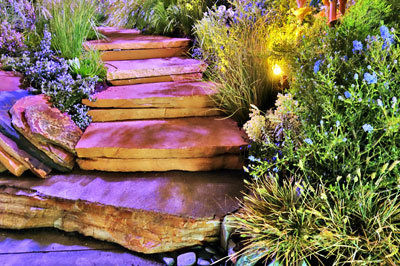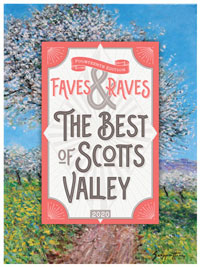Every year, I look forward to the San Francisco Flower & Garden Show, held each March, for inspiration and landscape design ideas.
It takes all day to look at everything, inspecting each display garden for new plant introductions and new uses for familiar varieties. Creative pathways and unique solutions for seating, arbors, water features, outdoor kitchens and patios greet you at every turn. Even the marketplace offers plants and garden objects that you simply must have in your own garden.
This year was no exception.
I started attending the San Francisco Flower & Garden Show back when it started in 1986 at Fort Mason in San Francisco. My father, a retired Army colonel, enjoyed it, because he was already familiar with the Army post. He accompanied me many times, even after the show moved to the Cow Palace. I always think of him when I’m at the show, because he nurtured my interest in gardening with those giant pansies in my first garden.
Now the show is at the San Mateo Event Center. It’s still a huge and complex production, using 150 dump-truck loads of sawdust and mulch and 280,000 pounds of rock to create the display gardens.
The drive up to San Mateo already starts me thinking about plants. The ceanothus on the hills are covered with cobalt blue flowers at this time of year, and the Western redbud are striking clothed in magenta blossoms.
Another native plant that caught my eye at the show was a yellow flowering currant, Ribes aureum gracillimum. Golden currants are native from the southern Bay Area to Riverside County. Masses of yellow flowers in early spring are enjoyed by Anna hummingbirds, bumblebees and Monarch butterflies. California thrashers and robins love the berries, which are edible and taste like Thompson seedless grapes. It’s a beautiful, low-water addition to the garden, along with another flowering currant, Ribes sanguineum “King Edward VII,” which has deep pinkish-red blossoms.
Several display gardens showcased a small tree with interesting contorted branches. The Twisty Baby dwarf black locust grows to only 15 feet tall and blooms at this time of year with fragrant, white flower clusters. Robinia species, in the legume or pea family, have nitrogen-fixing bacteria on their root systems. For this reason, they can grow on poor soils and are early colonizers of disturbed areas. They were planted well beyond their native range in Eastern United States by settlers seeking a fast source of homestead shade and hardwood fence posts. Early settlers of our area planted them, too, and they can still be seen along Highway 9 in some areas.
In the marketplace of the show, I couldn’t resist buying some metal bird sculptures hand-crafted from castoff 55-gallon steel drums. Artists in Haiti create the garden art, which is sold through Beyond Borders, providing them access to global markets. The fair-trade movement helps build sustainable trading partnerships that honor the value of labor and dignity of people.
Another booth offered pine-needle baskets and trays created in the mountains of Mexico. Weavers collect long pine needles off the forest floor and bundle them together. Many were trimmed with sand-cast polished nickel alloy trim, which has the luster of silver but requires no polishing. These handmade baskets and trays are beautiful and functional.
The Western Horticultural Society offered its Hot Plant Picks for 2013, and several caught my eye. With silver foliage, the Spanish lavender known as Lavandula stoechas “Silver Anouk” would make a great addition to any garden. Ditto for a new lavender-flowering, variegated westringia, “Wynyabbie Highlight,” which is said to be deer resistant. I also really liked a newly introduced “Lemon Light” Salvia greggii and a dwarf leucadendron called “Little Bit.”
My visit to the San Francisco Flower & Garden Show was fun and educational this year. I’ll be using these new plants whenever I can in gardens I design this year.
– Jan Nelson, a landscape designer and California certified nursery professional, will answer questions about gardening in the Santa Cruz Mountains. Email her at ja******@*ol.com, or visit www.jannelsonlandscapedesign.com to view past columns and pictures.













